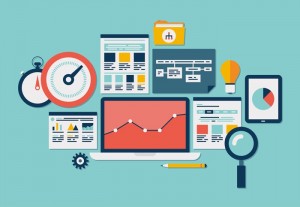The world nowadays is full of all sorts of data. With so much information from such a wide range of sources being compiled on a daily basis, we need to be capable of processing and analysing it extremely quickly. We also want information and knowledge immediately to hand, and are becoming almost spoiled by its instant availability. At the same time, we live in an age where everything is compressed into ever smaller chunks: through Twitter, text messages, one-second movies and other similar tools.
The result is that we want insights now, and in bite-sized chunks, please.
And this trend is seen more and more in the business domain too. One of its manifestations is a booming demand for 2.0 data visualisations, which are characterised by self-serviceability, scalability, interactivity and analytical character. But this creates its own challenges.
Fast, faster, now!
Over the last couple of years, we have seen a transformation in business intelligence (BI). Today, nobody can afford to wait for weeks or months for a report to be compiled. The traditional approach, now often perceived as obsolete, entrusted such tasks to the IT department, to process on a ‘first come, first served’ basis, often taking a long time because of the high level of demand. But more than half (57%) of respondents in a study conducted by TDWI indicated that a catalyst for introducing a self-service BI platform was a desire to move away from this model.
Instead, analysts nowadays must be capable of adding new data fast, defining data hierarchies, and balancing detailed and aggregated datasets. There are a huge number of queries coming from business executives, so the process of testing, developing and expanding business analyses must be performed at high speed.
Interactive and versatile
Another factor which shapes expectations of BI is a substantial increase in the level of analytic awareness among business executives. Company directors and board members are now much more likely to make precise demands for complex statistics. They also expect to see visually attractive presentations of different time ranges, other business segments, or geographical areas, and to be able to interrogate them. By choosing a bar, dashboard or point, they expect to be able to proceed with a detailed analysis and supplement tables or charts with notes, or share their insights with others.
Company directors and board members are now much more likely to make precise demands for complex statistics. They also expect to see visually attractive presentations of different time ranges, other business segments, or geographical areas, and to be able to interrogate them. By choosing a bar, dashboard or point, they expect to be able to proceed with a detailed analysis and supplement tables or charts with notes, or share their insights with others.
What if a brand new data mining approach is needed? Or a new interaction between visualisations? Executives expect changes like this to be possible immediately, as well.
Hindsight is not enough. It is time for predictive analytics
The true value of analytic work, including visual analyses, is not its ability to describe and assess past events. Instead, it is in the possibility of predicting, forecasting and anticipating key business phenomena. Companies do not just want sales results summaries, logistic process efficiency analyses and customer churn reports. They also want sales forecasts, out-of-stock predictions and customer churn risk analyses. Time series models, decision trees, and correlation or regression analyses are no longer tools for a chosen few.
Business users are becoming much more aware. They are more than able to read and understand simple visualisations in the form of linear charts, decision graphs or coloured value matrixes. Analytic support therefore needs to become more democratised. In other words, analytic products should be usable in widely-disseminated reports and statistics.
Multiple data, many users – are you ready?
When implementing SAS Visual Analytics solutions, we often notice that our customers expect these visualisation tools to facilitate their day-to-day analytic processes.  Good news about new and high-quality tools tends to spread fast across organisations. Presumably, therefore, soon after initial implementation, we should see the emergence of new business teams attracted by the benefits of self-service BI. The BI Survey 14 report published by BARC found that 55% of BI platform users already take advantage of self-service solutions, and 24% are planning to do so in the near future. Is your platform ready to support these users? Even if it is, in terms of its efficiency, what would be the costs of such support? A nominally ‘free-of-charge’ solution can break the budget if you have to pay for each new user. Cheap implementation can turn out to be a trap leading to very high costs.
Good news about new and high-quality tools tends to spread fast across organisations. Presumably, therefore, soon after initial implementation, we should see the emergence of new business teams attracted by the benefits of self-service BI. The BI Survey 14 report published by BARC found that 55% of BI platform users already take advantage of self-service solutions, and 24% are planning to do so in the near future. Is your platform ready to support these users? Even if it is, in terms of its efficiency, what would be the costs of such support? A nominally ‘free-of-charge’ solution can break the budget if you have to pay for each new user. Cheap implementation can turn out to be a trap leading to very high costs.
The new era of visualisation requires much more than just an attractive chart or infographic representation. These have been around for centuries. If they are to facilitate decision-making, self-service BI tools require the broad array of functionalities in the four areas described.
Learn more about the data visualization or check how you can explore data with SAS Visual Analytics.
